20 Ducks with Black And White Heads (with Pictures & ID Guides)
Black-and-white heads on ducks are striking and instantly noticeable. That bold contrast makes these ducks stand out, whether they’re gliding across a pond or taking flight.
But why do some ducks have black and white heads?
There are a few reasons. For some species, the pattern helps them recognize each other, especially during mating season, while for others, it may serve to intimidate rivals or confuse predators. The coloration can also play a role in courtship, letting a drake show off his fitness and catch the eye of a potential mate.
To celebrate these eye-catching birds, we’ve put together a list of ducks with black-and-white heads. Some are familiar to backyard birdwatchers, while others are rarer, each with its own unique charm and story.
- 1. Bufflehead
- 2. Hooded Mergansers
- 3. Long-tailed Duck
- 4. Common Eider
- 5. Muscovy Duck
- 6. Steller’s Eider
- 7. White-faced Whistling Duck
- 8. White-headed Duck
- 9. Harlequin Duck
- 10. Smew
- 11. Common Goldeneye
- 12. Ancona Duck
- 13. Ruddy Duck
- 14. Surf Scoter
- 15. Blue-winged Teal
- 16. Pacific Black Duck
- 17. Knob-billed Duck
- 18. Spot-billed Duck
- 19. Puna Teal
- 20. Pink-eared Duck
1. Bufflehead
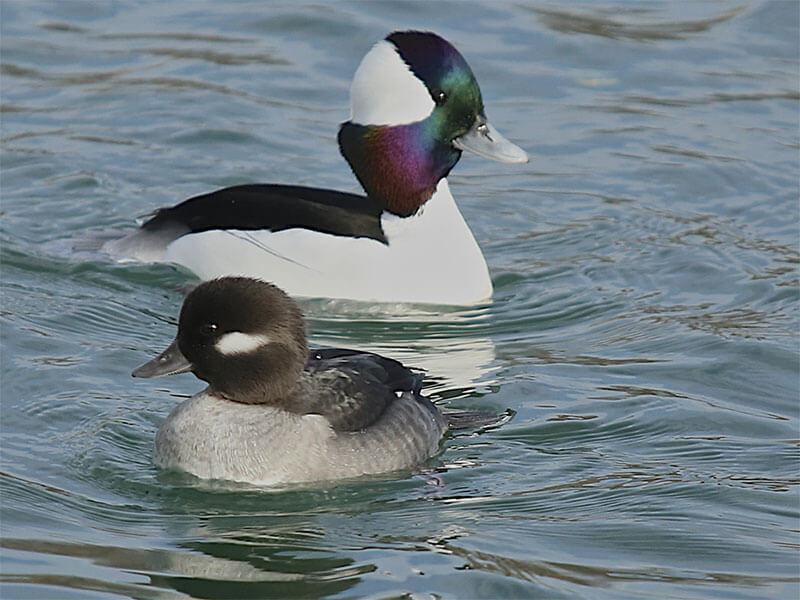
If you love small, energetic ducks, the bufflehead is a must-see. Male buffleheads are eye-catching with bold black-and-white heads, highlighted by a large white patch behind the eye that gleams when the sunlight hits. Their heads also shimmer with hints of green and purple, giving them an iridescent glow. Females are more muted in color, with soft grey tones and a smaller white patch near the eye. These tiny divers are constantly active, darting through the water in pursuit of food, and you usually spot them in small, lively groups rather than huge flocks.
2. Hooded Mergansers
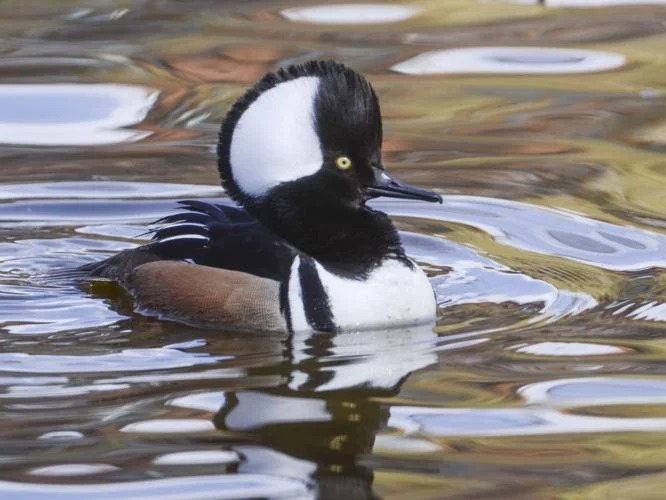
The hooded merganser is a true showstopper, especially the males in breeding plumage. Their head is mostly black with dramatic white patches on either side of their large crest, which they can raise to impress mates. The contrasting black-and-white head makes them easy to spot even from a distance. Females are softer in appearance, with grey-brown heads and a reddish-brown crest, but they also carry a subtle white patch near the lower breast. These ducks are relatively small and highly agile, darting through freshwater habitats with grace.
3. Long-tailed Duck
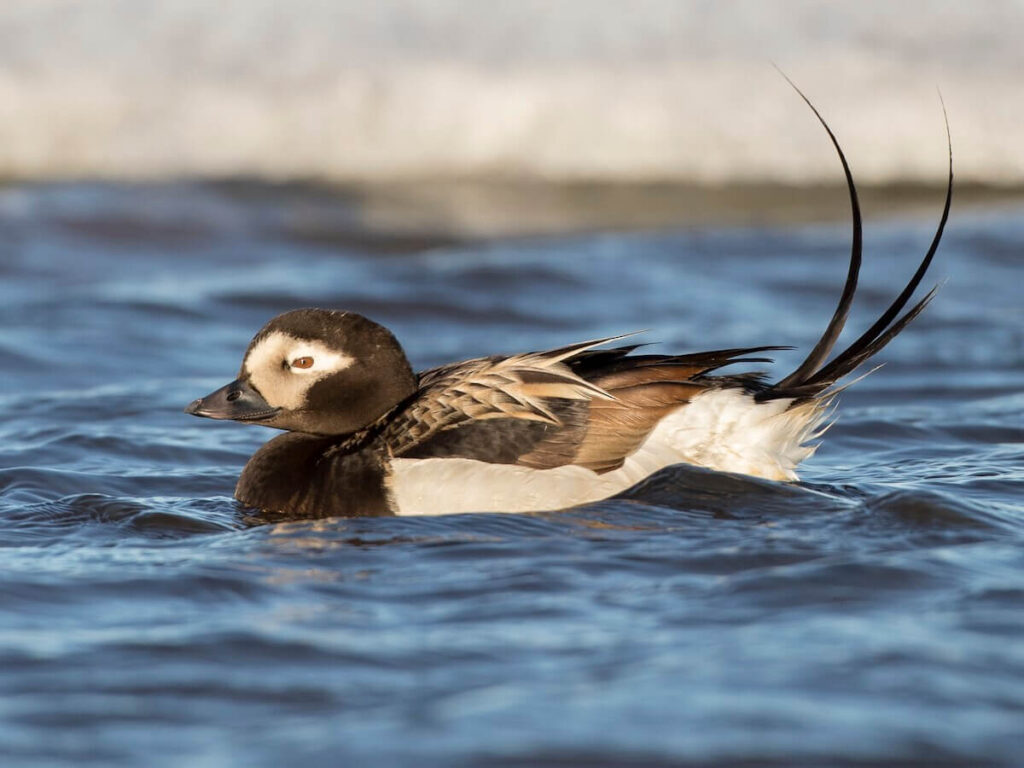
Long-tailed ducks are wintering marvels along northern coasts. The males show off a striking black-and-white head pattern that changes with the seasons. In winter, their heads are mostly white with a dark cheek patch, while summer brings darker heads with a bold white cheek. Females keep things simpler with brown backs and white winter heads topped with a dark crown. Both sexes have distinctive pointed tails that make them easy to identify. Watching them dive and surface is a real treat for birdwatchers.
4. Common Eider
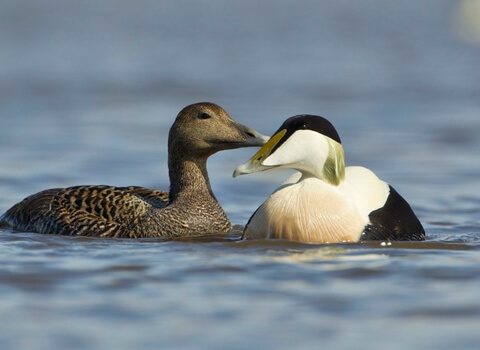
The common eider is a giant among ducks, yet its black-and-white head patterns are surprisingly elegant. Male eiders have dramatic head markings that contrast sharply with their body colors, while females are more muted with softer tones but still display a subtle mix of white and dark feathers on the head. You’ll likely find these sea ducks in northern coastal waters. Their bold black-and-white head markings make them easy to pick out, even in a crowded flock.
5. Muscovy Duck
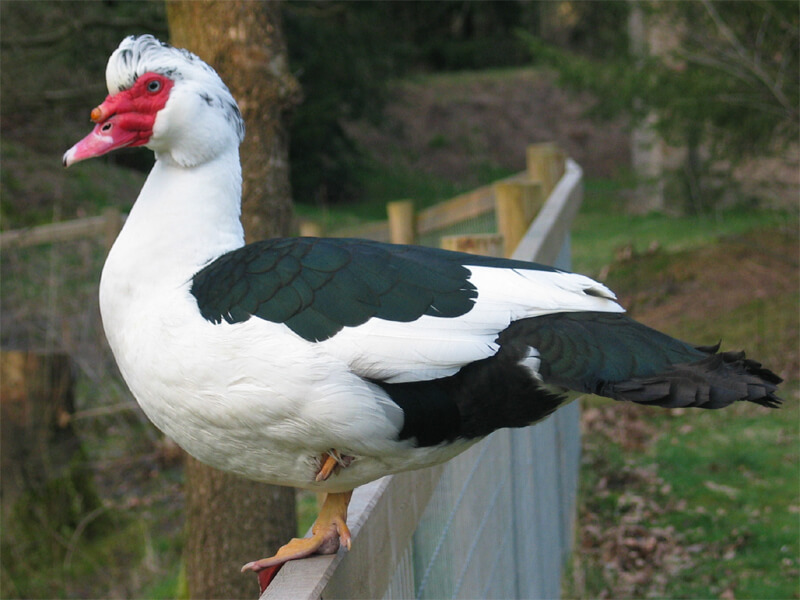
Muscovy ducks are unusual and charming, with a distinctive face often showing a wide range of colors, including patches of black and white feathers along with red facial caruncles. Males are larger and show bolder head markings, while females have more delicate patterns. These ducks are not only fascinating to look at but are also quieter than many other domestic ducks, making them easy to observe in ponds and wetlands.
6. Steller’s Eider
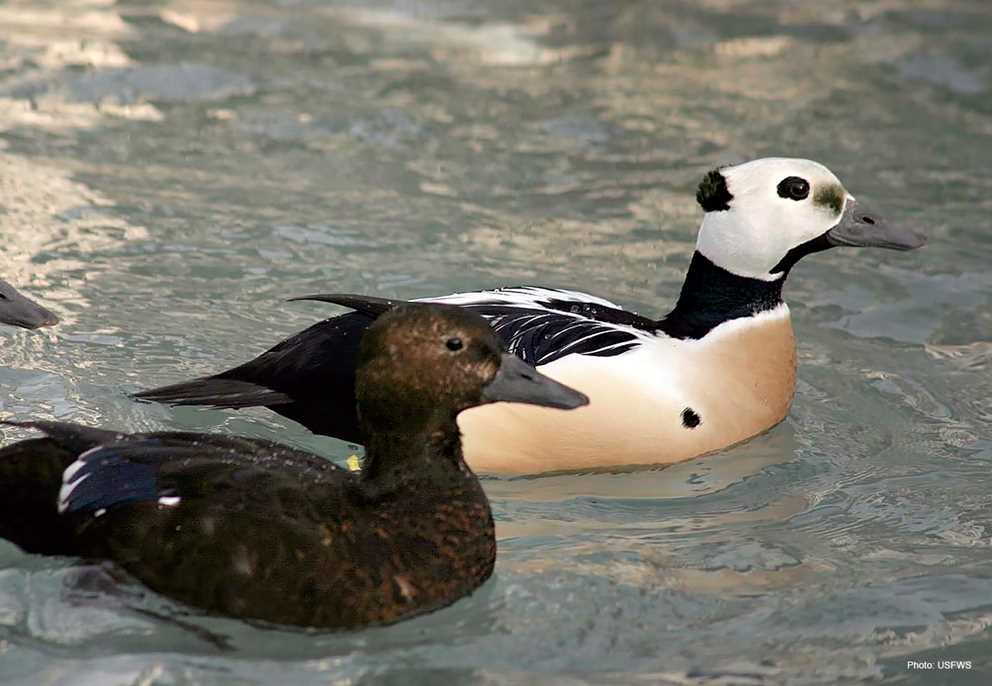
If you’re exploring Arctic waters, the Steller’s eider is a rare gem to spot. Male Steller’s eiders in breeding plumage show a striking black-and-white head with a black cap, chin, and throat set against a mostly white face and shoulders. Light green patches behind the head add extra flair. Females are subtler, with brownish heads and a pale white eye-ring, yet their heads still show a delicate mix of light and dark feathers. Despite being the smallest eider, these ducks are fast flyers and agile swimmers, making them a delight for birdwatchers to observe in their coastal habitats.
7. White-faced Whistling Duck
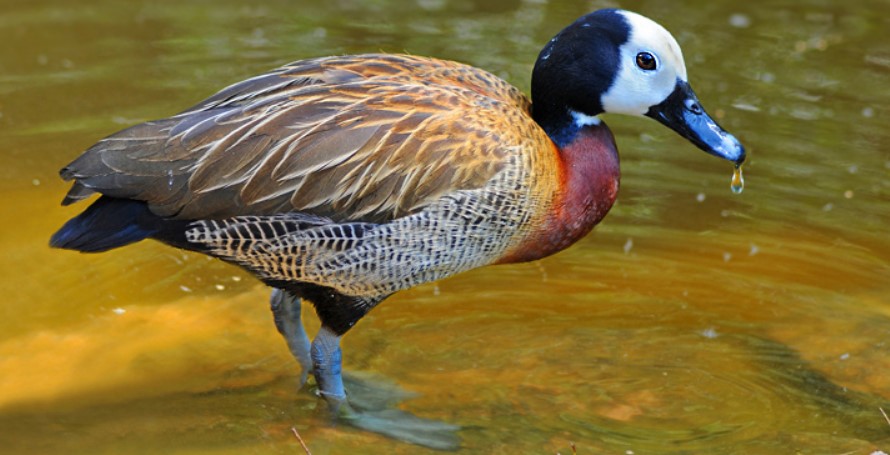
The white-faced whistling duck is instantly recognizable thanks to its unique head pattern. Its face is mostly white, contrasting sharply with the black neck and head. Both males and females share this bold head design, which stands out against dark brown wings and back. Juveniles have a softer, less contrasted head pattern, but they still show hints of the classic white-and-black look. These ducks also have long heads and legs, giving them an elegant, almost regal posture as they wade or swim.
8. White-headed Duck
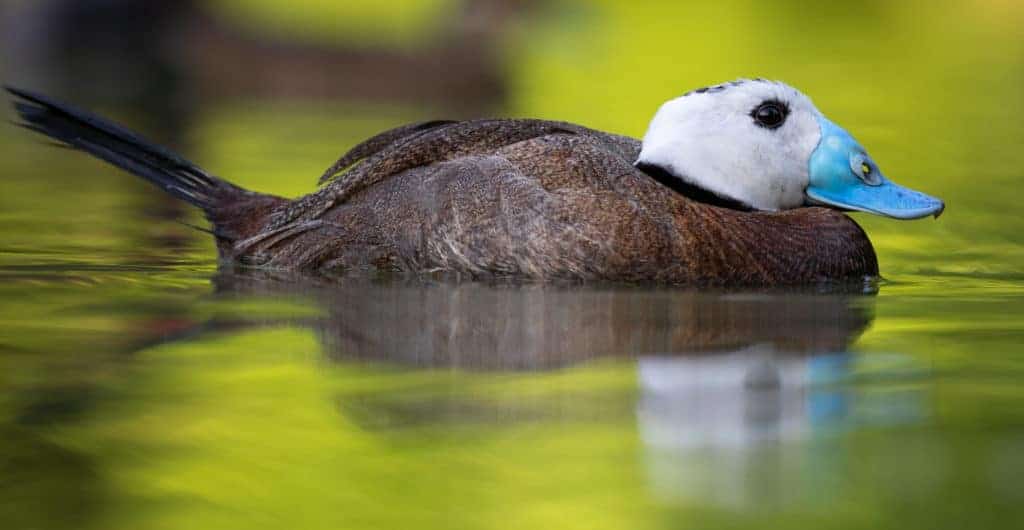
The white-headed duck is a small diver with a head that can’t be missed. Males have a bright white head topped with a black cap and neck, paired with a blue bill that adds a splash of color. Females are less showy but still display a white face with darker cap and cheek markings. Their black-and-white head makes them easy to spot on calm lakes, especially as they dive and resurface in search of aquatic plants.
9. Harlequin Duck
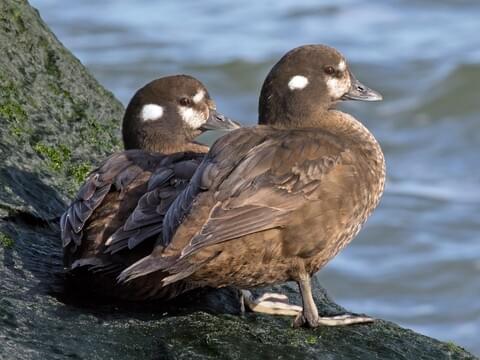
Even the female harlequin duck shows off a dramatic black-and-white head pattern. She has three distinct white patches: one round spot behind the eye, a larger patch running from the eye to the bill, and a small spot above the eye. While less colorful than males, this striking head pattern makes her easy to identify, and her overall slate-brown body and subtle markings still have a quiet elegance.
10. Smew
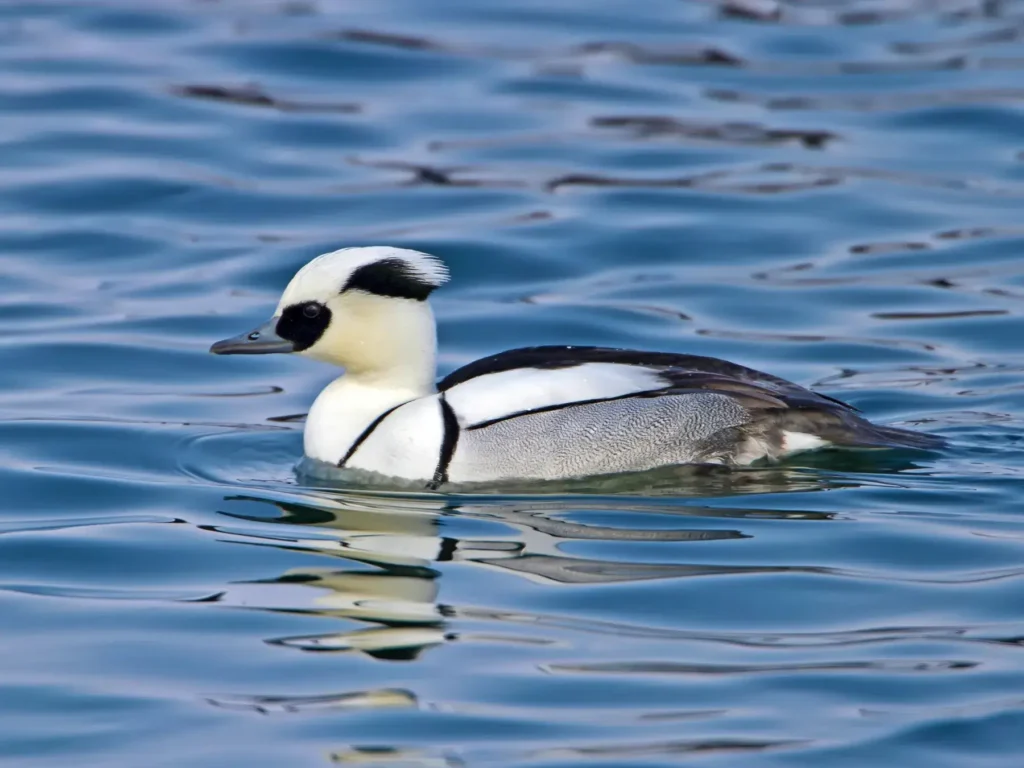
The smew is like a little flying panda! Adult males are mostly white with bold black markings on the head and body, giving them a striking black-and-white look in flight. Females and young males are greyer but still have a white face with black around the eyes, making their heads stand out. Their sharp, hooked bills help them catch fish as they dive, and those black-and-white patterns make spotting them an exciting experience for birdwatchers.
11. Common Goldeneye
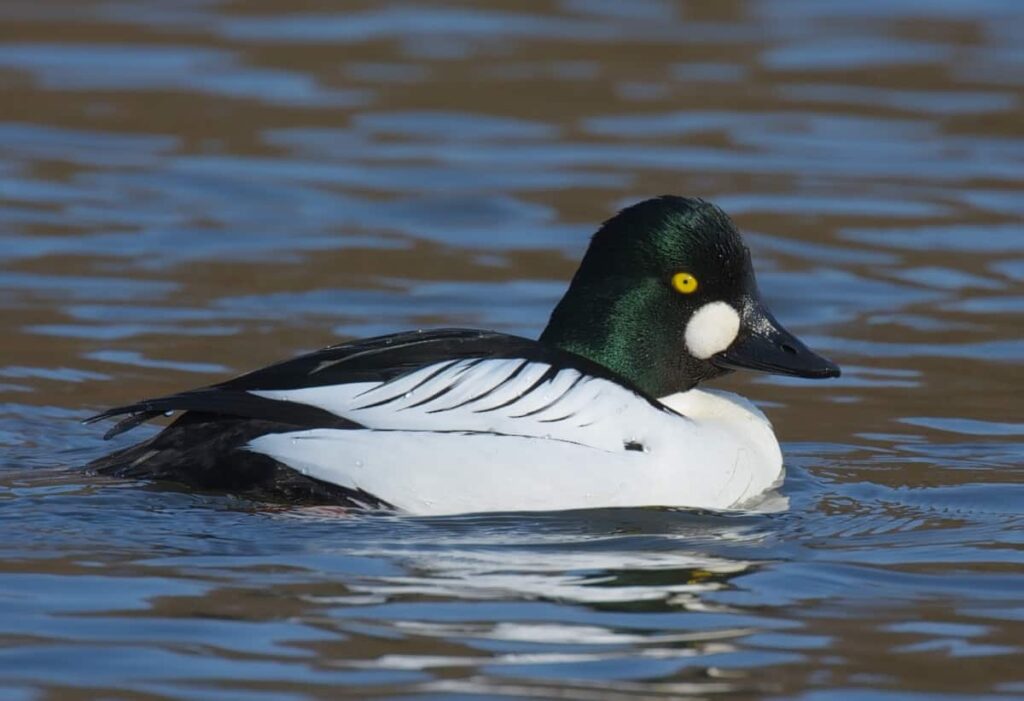
The common goldeneye is a diving duck that’s hard to miss because of its bold head pattern. Adult males have a dark, glossy green head with a striking round white patch just below the eye, which contrasts beautifully with their black back and white belly. Females are subtler, with a brown head and mostly grey body, but you can still notice the clean lines on their heads. Their golden-yellow eyes add a splash of color that lives up to the name. These ducks are energetic swimmers and divers, often disappearing below the water to catch crustaceans and insects.
12. Ancona Duck
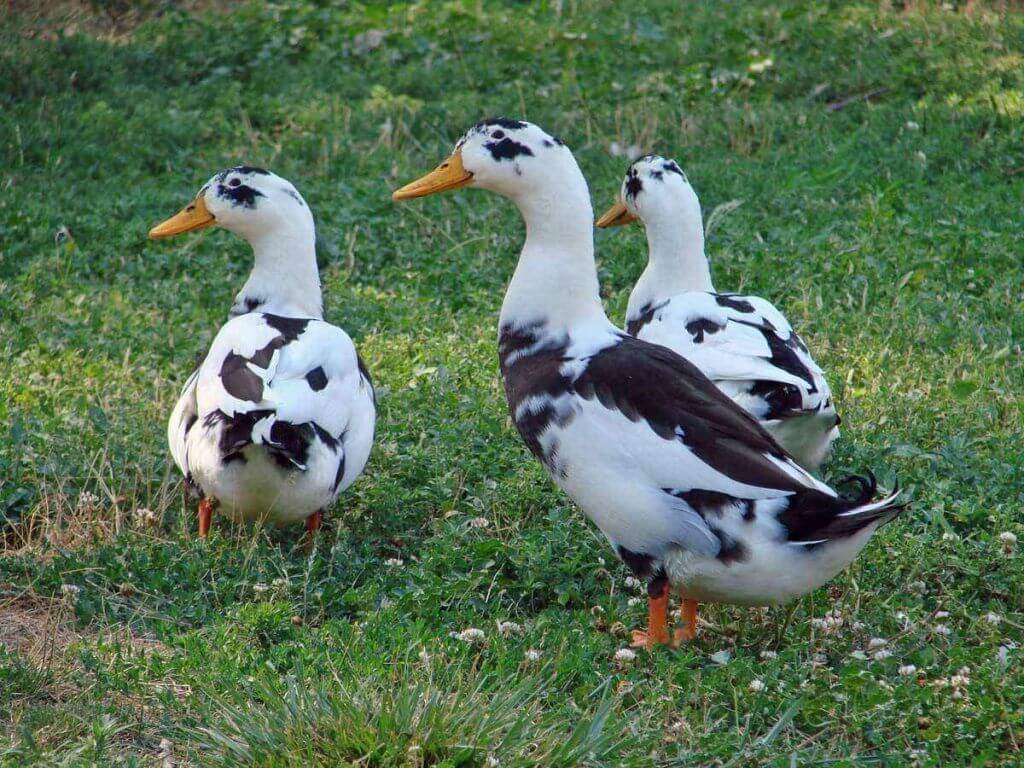
Ancona ducks are domestic ducks with a fun, patchy look that makes each one unique. Many Anconas show black-and-white patterns on their heads, though the exact markings can vary from bird to bird. Some may have mostly white faces with black spots, while others have a more balanced mix of the two colors. Their playful, broken-colored plumage continues across the body, giving them a striking and distinctive appearance that’s easy to recognize.
13. Ruddy Duck
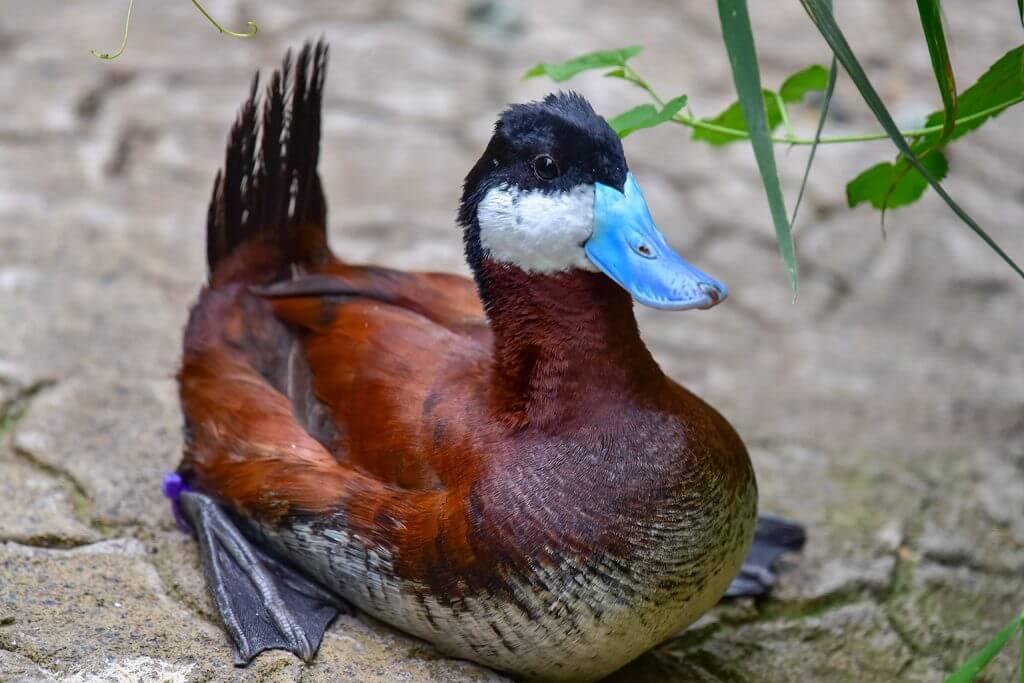
The ruddy duck is small but packed with personality, and its head is a real highlight. Males in breeding season have a blackish cap that stands out against bright white cheeks, while females and young males have softer, pale cheek patches with a blurry stripe. The stark black-and-white contrast on the male’s head makes it a favorite for birdwatchers, especially when paired with the bright blue bill during summer.
14. Surf Scoter
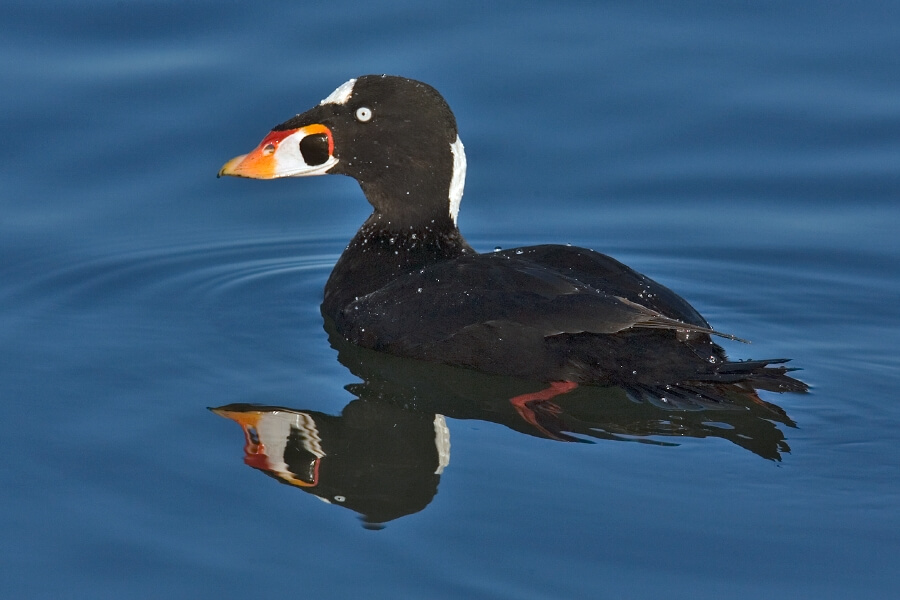
The surf scoter has a bold black-and-white head pattern that’s unforgettable. Adult males are mostly black, but their forehead and nape show bright white patches that pop in contrast. The females are browner with paler cheek patches, but they still carry hints of white that make their heads easy to spot. These unique head markings, along with the male’s multicolored swollen bill, make the surf scoter a striking bird on northern coasts.
15. Blue-winged Teal
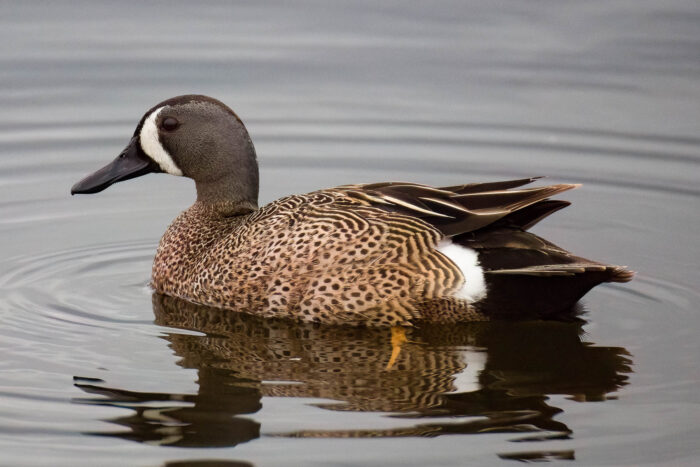
While not entirely black-and-white, the blue-winged teal shows a clear head pattern that birdwatchers love. Adult males have a greyish-blue head with a white crescent running from the eye toward the cheek, giving a two-tone effect. Females are mottled brown but display a whitish area near the base of the bill. This subtle mix of light and dark on the head helps you identify them, especially when they show off their bright sky-blue wing patches in flight.
16. Pacific Black Duck
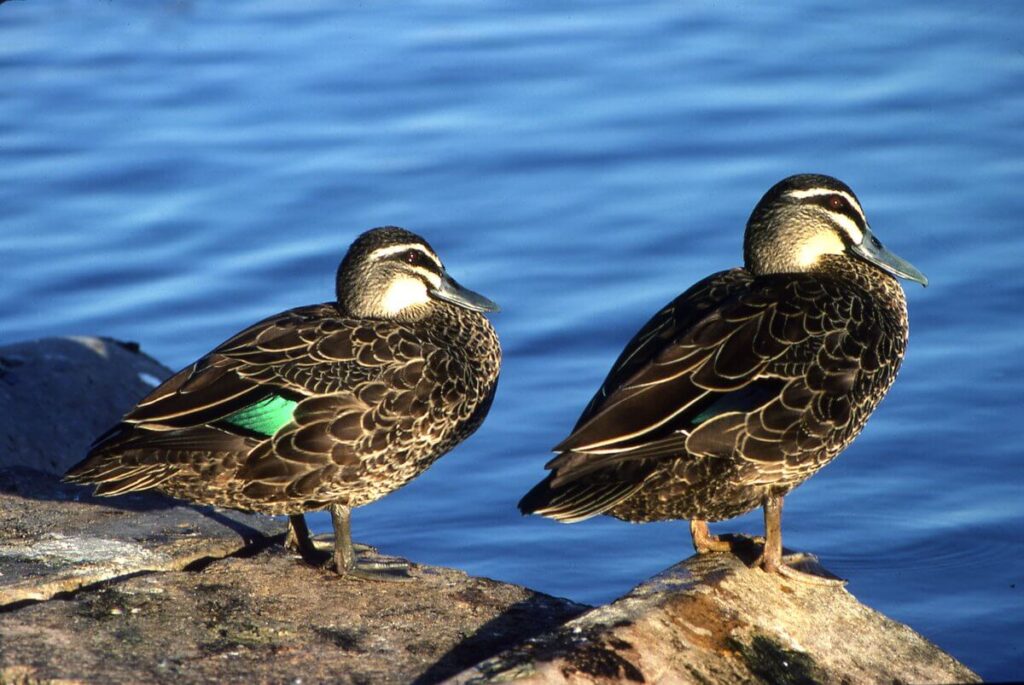
The Pacific black duck is easy to recognize thanks to its soft, pale head marked with a dark crown and facial stripes. These subtle contrasts on the head give it a gentle black-and-white appearance, especially noticeable when the bird is gliding or flying. The rest of its body is darker, and in flight, a green speculum flashes against pale underwings. Males are usually a bit larger than females, but all have that characteristic patterned head that helps birdwatchers identify them from afar.
17. Knob-billed Duck
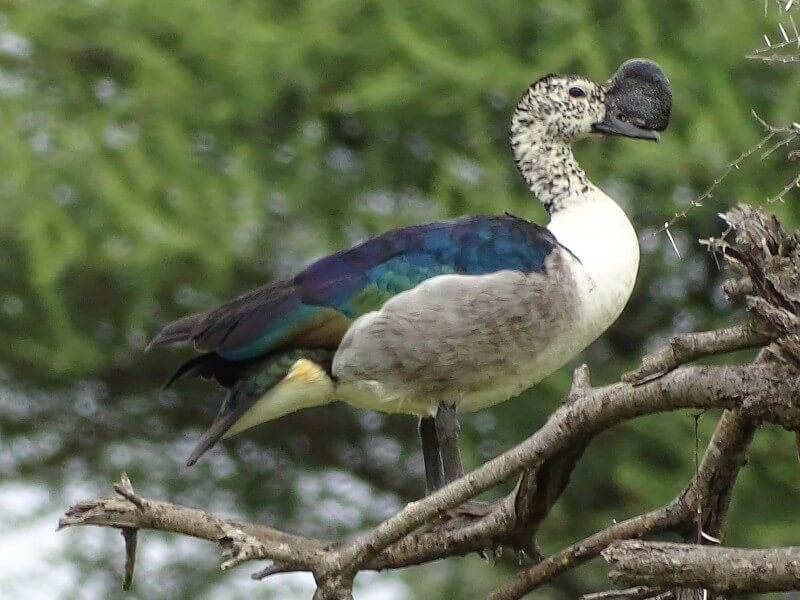
If you want a duck with a bold black-and-white head, the knob-billed duck is a showstopper. Adults have a mostly white head covered with dark speckles and a pure white neck and underparts. The contrast between the head and the glossy, iridescent blue-black upperparts really makes this duck stand out. Males also sport a large black knob on the bill, adding even more character to their striking appearance. Juveniles are duller but still show hints of the head pattern, making it easier to tell them apart once you know what to look for.
18. Spot-billed Duck
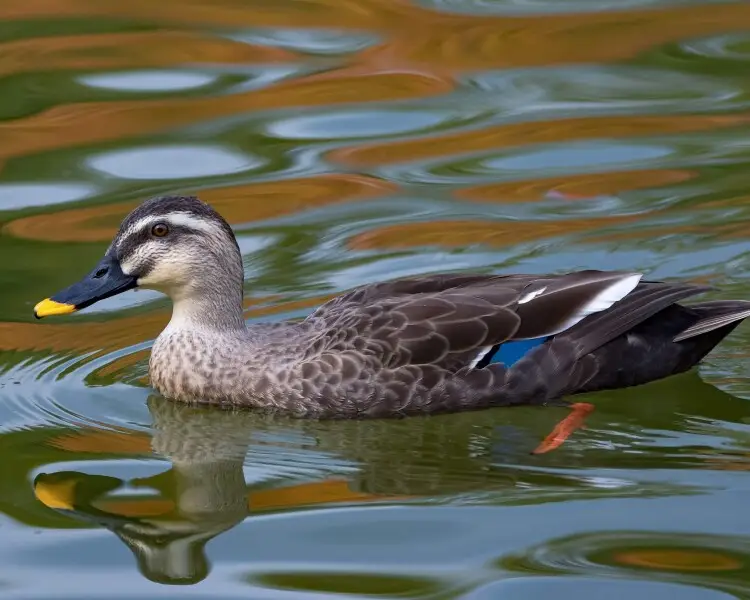
The spot-billed duck is a clever mix of patterns and colors, with a head that often appears black-and-white from a distance. The long neck and distinctive yellow spots at the base of the bill stand out against the lighter head, and white tertial stripes on the sides add to the contrast. When the duck takes flight, the blue speculum and broad white bands on the wings highlight its head markings, making it easier to identify among other waterfowl.
19. Puna Teal
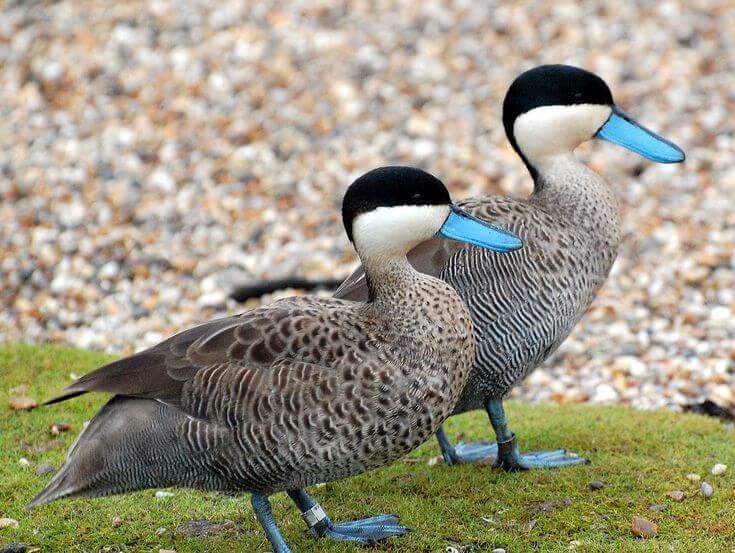
The Puna teal shows off one of the most dramatic black-and-white head patterns in the duck world. Its black cap stretches below the eyes, contrasting sharply with the creamy-white lower face and neck. This two-tone effect is complemented by its light coffee-colored body with dark spotting, making the head the star feature. With a large light-blue bill accented by a black line, the Puna teal is a real favorite for birdwatchers looking for bold and distinct head patterns.
20. Pink-eared Duck
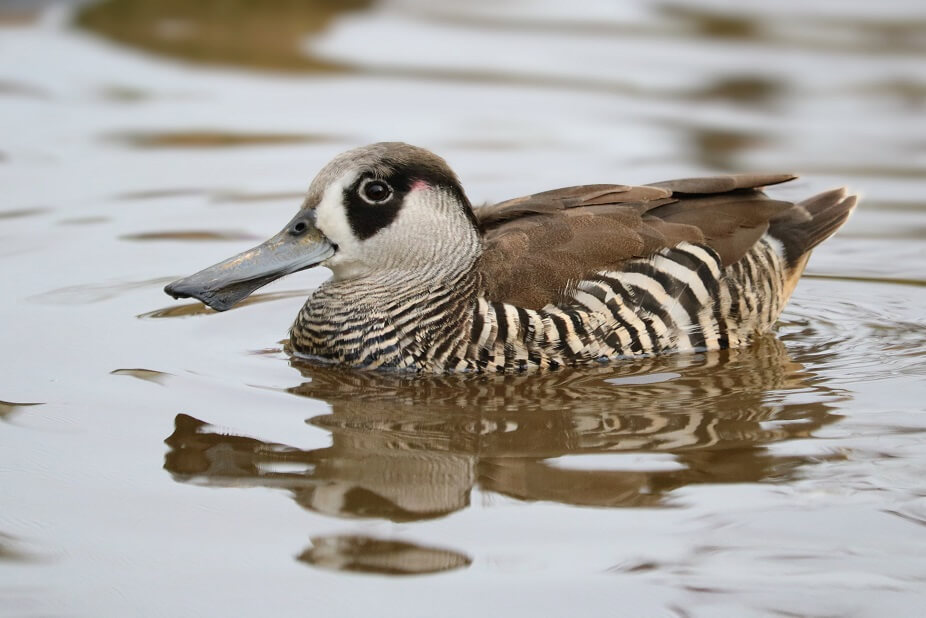
You won’t easily mistake a Pink-eared Duck for anything else. Even from a distance, its bold black-and-white facial pattern makes it stand out among other waterbirds. Look closely at the head, and you’ll see wide, dark stripes stretching across its face, broken by patches of bright white. Just behind the eye sits a small blush-colored spot, which gives this duck its charming name.
Unlike most ducks, it has a unique, spoon-shaped bill with fine grooves along the side—perfect for filtering tiny creatures from shallow water. Their bodies are softly patterned with cinnamon-brown sides and fine gray and white barring, but it’s really that black-and-white head that draws your eye first.
